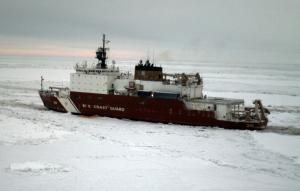Center assists United States Coast Guard with Nome fuel delivery
University of Hawaiʻi at MānoaContact:
Marcie N W Grabowski, (808) 956-3151
Outreach Coordinator, SOEST
Margo Edwards, (808) 956-5232
CIMES Director
Outreach Coordinator, SOEST
Margo Edwards, (808) 956-5232
CIMES Director
Posted: Jan 25, 2012

USCG Cutter HEALY safely navigates toward Nome, AK using sea-ice data collected by CIMES researchers
Researchers with the Center for Island, Maritime and Extreme Environment Security (CIMES), headquartered at UH Mānoa’s School of Ocean and Earth Science and Technology (SOEST), have been providing the United States Coast Guard (USCG) Cutter HEALY with critical information about sea ice thickness as the icebreaker leads the Russian tanker Renda on a mission to deliver fuel to Nome, Alaska.
The typical pre-winter delivery of fuel by barge to Nome did not take place this year because of offshore storms last November. Using an Aeryon Scout unmanned aerial vehicle (UAV) launched from shore, Dr. Gregory Walker, with the Geophysical Institute at the University of Alaska Fairbanks (UAF), and his colleagues continue documenting daily ice conditions and transmitting the information to HEALY to help the icebreaker avoid dangerous obstacles such as pressure ridges that form when ice surfaces push together.
“The Department of Homeland Security’s Office of University Programs established CIMES four years ago to strengthen collaborations between the USCG, as well as harbor masters and other first responders, and University scientists and engineers,” said Dr. Margo Edwards, CIMES Director and a Senior Research Scientist with the Hawai‘i Institute of Geophysics and Planetology at the University of Hawai‘i at Mānoa. “The effort by UAF/CIMES researchers to support never-before-attempted USCGC HEALY operations demonstrates the value of these partnerships to both the participants and the affected communities, in this case the residents of Nome.”
In addition, improved real-time awareness of sea-ice conditions will demonstrate how new technology can revolutionize operations in sea ice, including beyond the visible sight from the ship. Added Walker, “As marine transportation through the Arctic region increases in tandem with retreating sea ice extent, this project provides a unique opportunity to safely integrate small, unmanned aircraft into USCG cutter operations as well as better understand and monitor rapid changes in the Arctic environment for the benefit of many Department of Homeland Security stakeholders.”
CIMES is focused on developing robust research and strong educational programs in geographic areas that present significant homeland security challenges. Its goal is to deliver revolutionary advances in maritime domain security capabilities that will allow for the eventual development and fielding of critically needed new capabilities. Initial efforts have been focused on developing technologies for persistent observations in challenging marine environments. CIMES partners include UH Mānoa, UAF, and the University of Puerto Rico – Mayagüez.
